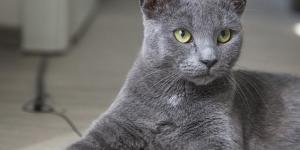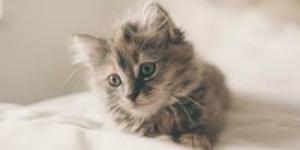British Longhair

The British Longhair cat comes from the cross between the British Shorthair and the Persian cat. Physically, they are similar to the British Shorthair, but have semi-long hair. They are known for their luxurious, silky and soft hair, which comes in more than 300 different colors and patterns. Their character is independent, playful, affectionate and calm. These cats love their families, but also enjoy spending time alone. This is the perfect breed for cat lovers who long to share their lives with a kitty, but do not have much time to spend together every day. The health of these cats is good as long as they are properly cared for. However, you need to be aware of some diseases that they are prone to due to the heredity of their parents.
AnimalWised brings you everything you need to know about the British Longhair breed. We look at the origin, characteristics, temperament, care, and possible health aspects of this hairless cat breed.
- Europe
- United Kingdom
- 7-11
- 11-13
- 13-17
- 17-22
- 22-30
- 8-10
- 10-15
- 15-18
- 18-20
Origin of the British Longhair cat
The British Longhair is a relatively new breed, descended directly from the British Shorthair cat. At the end of World War I, the population of the British Shorthair had declined dramatically. Breeders worked hard to save these incredible cats by crossing them with several other breeds, including Persians.
However, since the main goal was not to create a new breed, but to preserve the British Shorthair breed, the long-haired specimens were excluded from breeding and given as pets neutered. British Shorthair cats still contain longhair genes, even if both parents are shorthair.
Over time, some breeders' associations have recognized the British Longhair as a distinct breed. The breeding standard is the same as for the shorthair cats, and they differ only in the length of their coats. Currently, this breed is recognized by the World Cat Federation (WCF), but not yet by the International Feline Federation (FIFE).
Physical Characteristics of the British Longhair cat
British longhaired cats have similar physical characteristics to their shorthaired relatives, except for the length of the coat. They measure between 28 and 30 cm (11 to 12 in), males can weigh up to 8 kg (17 lbs.), and females weigh between 4 and 6 kg (9 to 13 lbs.). Their main physical characteristics are as follows:
- Body: Medium to large, muscular body and deep, broad chest.
- Head: Rounded and broad with strong chin. The whisker pads and cheeks are pronounced and give the impression of a smile.
- Ears: The ears are small, broad at the base and rounded at the tips.
- Eyes: Large and round eyes which emphasize the roundness of the face. Many British Longhair cats have golden eyes, but shades of green, emerald, and blue also occur.
- Tail: The tail is about ⅔ of the body length long, thick and with a round tip.
- Legs: The legs are strong and muscular and are in proportion to the body.
British Longhair cat coat colors
The British Longhair Cat has an impressive double coat with a thick, plush undercoat and a soft, silky topcoat. British Longhair cats come in every color and pattern imaginable. Nose leather and paw pads should complement the coat color. Although the coat comes in more than 300 different colors and patterns, the most common coat colors are:
- Chocolate
- Cinnamon
- Silver
- Fawn
- Blue
- Black
- Cream
- White
- Red
Temperament of the British Longhair Cat
British Longhair cats are characterized by a calm, even-tempered, reserved and independent personality. They are affectionate to their caregivers, but more independent and less clingy than other breeds, without being grumpy. It is a cat that adapts very well to different types of households, as well as to children and other animals. However, they are somewhat shy and suspicious of strangers.
They are very good hunters and will not hesitate to chase any small animal in the house. They are also very playful and demand affection whenever they want it. It is not a breed that follows their caregivers around, constantly asking for affection.
If you are interested in adopting a cat with a calm temperament, do not miss this other article, where we describe which cat breeds are the calmest and most independent.
Care of the British Longhair Cat
Like any other cat, your cat should go to the vet at least once a year for a checkup and annual vaccination, and immediately if it is sick or injured. In addition, you should always provide your cat with toys and games to keep them physically and mentally stimulated. Although the British Longhair cat is easy to keep thanks to its independent character, there are some things you need to know to take the best care of your British Longhair cat.
- Feeding: since British Longhairs tend to overeat, it is important to pay attention to their diet to avoid excessive weight gain. Feeding a high-quality food that is high in protein and low in carbohydrates can help reduce the risk of weight problems.
- Grooming: British Longhairs need to be groomed daily, even as tiny kittens, so they are familiar with the process and comfortable before the thick coat grows back. They will try to groom themselves, but are unlikely to be successful at it.
- Exercise: Since British Longhair cats like to relax and are naturally less active than many other cat breeds, they may need some encouragement to play. Therefore, it is important that you keep your British Longhair mentally stimulated, motivated, and spending time with her each day.
Cats are known for their self-care. It is rare for our cat to be dirty, as he spends much of the day licking himself clean, often in a severely contorted manner. While this can be amusing, it is also reassuring. It tells us that the cat is healthy and ready to take care of itself. Read on in this other article if you want to learn more about the importance of grooming in cats and what it means when they stop grooming themselves.
Health of the British Longhair Cat
British Longhair cats can live up to 18 years as long as they are properly cared for and fed, and routine examinations and prompt diagnosis of any health problems that may affect them are maintained. Although they are susceptible to any type of disease or infection that affects cats, British Longhair cats seem to be more susceptible to certain diseases, such as:
- Overweight and obesity: excess body fat and weight can result in serious health consequences such as diabetes mellitus, urolithiasis and heart disease.
- Polycystic kidney disease: fluid-filled cysts occur in the kidneys and can grow to the point of causing kidney damage and leading to kidney failure.
- Hypertrophic cardiomyopathy: Thickening of the heart muscle occurs, which restricts the space for blood to pool in the heart chambers and can lead to heart failure.
- Neonatal Isoerythrolysis: British cats are usually blood type B. If they were crossed with a group A or AB male, the group A or AB kittens would suffer from this disease when nursing and could die after an immune-mediated reaction with rupture of the red blood cells (hemolysis).
Where to adopt a British Longhair Cat
If you want to adopt a British Longhair, you are best off with a reputable breeder, because this breed is not very common or well known. It is not impossible to find a British Longhair cat for adoption at your local shelter or another animal shelter, but it is rare. Please check with the adoption organization if you are looking to adopt a cat for details about the cat's character.
Remember, before adopting any cat, consider whether you are truly a suitable candidate. You need to make sure you have the time and commitment a living creature needs to have a good quality of life.
British Longhair photos
















